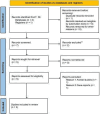The Impact of CD34+ Cells on Wound Healing Outcomes in Oral and Maxillofacial Surgery: A Systematic Review of Randomized Controlled Trials
- PMID: 40486386
- PMCID: PMC12142278
- DOI: 10.7759/cureus.83633
The Impact of CD34+ Cells on Wound Healing Outcomes in Oral and Maxillofacial Surgery: A Systematic Review of Randomized Controlled Trials
Abstract
Despite significant advancements in surgery and biomaterials science, delayed healing and related complications remain major challenges. Emerging studies have highlighted the promising role of CD34+ cells in promoting accelerated wound healing. This systematic review aims to comprehensively evaluate the impact of CD34+ cells on healing outcomes in oral and maxillofacial surgery. A thorough search was conducted using PubMed and the Cochrane Library (CENTRAL via Ovid), complemented by manual screening of additional articles. Only randomized controlled trials (RCTs) involving systemic or local administration of CD34+ cells were included. Healing time and complication rates were the primary outcomes assessed. The review followed the Preferred Reporting Items for Systematic reviews and Meta-Analyses (PRISMA) guidelines and employed the Cochrane Risk of Bias 2 tool for quality assessment. Three relevant RCTs met the inclusion criteria. Regardless of the assessed risk of bias, all studies supported the potential therapeutic benefits of CD34+ cell-based interventions in oral and maxillofacial surgery. However, the findings also revealed significant gaps in current knowledge within this field. Overall, CD34+ cells show strong potential in enhancing wound healing in oral and maxillofacial procedures. This review lays the groundwork for future regenerative strategies aimed at optimizing surgical outcomes in this specialized area. The application of CD34+ cells in such contexts appears to be technically justified.
Keywords: acute and chronic wounds; acute wounds; cd34; chronic wounds; healing; maxillofacial; rct; regeneration.
Copyright © 2025, Sivakumar et al.
Conflict of interest statement
Conflicts of interest: In compliance with the ICMJE uniform disclosure form, all authors declare the following: Payment/services info: All authors have declared that no financial support was received from any organization for the submitted work. Financial relationships: All authors have declared that they have no financial relationships at present or within the previous three years with any organizations that might have an interest in the submitted work. Other relationships: All authors have declared that there are no other relationships or activities that could appear to have influenced the submitted work.
Figures
References
-
- Prakash P, Bahri R, Bhandari SK. Beauty - Cosmetic Science, Cultural Issues and Creative Developments. Rijeka: IntechOpen; 2021. Maxillofacial defects: impact on psychology and esthetics.
-
- Schultz GS, Chin GA, Moldawer L, et al. Mechanisms of Vascular Disease: A Reference Book for Vascular Specialists [Internet] Adelaide (AU): University of Adelaide Press; 2011. Principles of wound healing. - PubMed
Publication types
LinkOut - more resources
Full Text Sources
Miscellaneous


